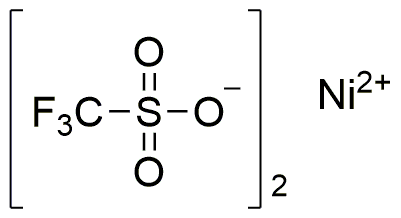Nickel(II) Trifluoromethanesulfonate is widely utilized in research focused on:
- Catalysis: This compound serves as an effective catalyst in various organic reactions, enhancing reaction rates and selectivity, particularly in the synthesis of complex molecules.
- Electrochemistry: It is used in electrochemical applications, including battery technology, where it helps improve the efficiency and performance of nickel-based batteries.
- Material Science: Nickel(II) Trifluoromethanesulfonate is employed in the development of advanced materials, such as conductive polymers and nanocomposites, which are crucial in electronics and energy storage.
- Pharmaceuticals: In medicinal chemistry, it acts as a reagent in the synthesis of pharmaceutical compounds, aiding in the creation of new drugs with improved efficacy.
- Environmental Applications: This chemical is explored for its potential in environmental remediation processes, particularly in the removal of heavy metals from contaminated water sources.
General Information
Properties
Safety and Regulations
Applications
Nickel(II) Trifluoromethanesulfonate is widely utilized in research focused on:
- Catalysis: This compound serves as an effective catalyst in various organic reactions, enhancing reaction rates and selectivity, particularly in the synthesis of complex molecules.
- Electrochemistry: It is used in electrochemical applications, including battery technology, where it helps improve the efficiency and performance of nickel-based batteries.
- Material Science: Nickel(II) Trifluoromethanesulfonate is employed in the development of advanced materials, such as conductive polymers and nanocomposites, which are crucial in electronics and energy storage.
- Pharmaceuticals: In medicinal chemistry, it acts as a reagent in the synthesis of pharmaceutical compounds, aiding in the creation of new drugs with improved efficacy.
- Environmental Applications: This chemical is explored for its potential in environmental remediation processes, particularly in the removal of heavy metals from contaminated water sources.
Documents
Safety Data Sheets (SDS)
The SDS provides comprehensive safety information on handling, storage, and disposal of the product.
Product Specification (PS)
The PS provides a comprehensive breakdown of the product’s properties, including chemical composition, physical state, purity, and storage requirements. It also details acceptable quality ranges and the product's intended applications.
Certificates of Analysis (COA)
Search for Certificates of Analysis (COA) by entering the products Lot Number. Lot and Batch Numbers can be found on a product’s label following the words ‘Lot’ or ‘Batch’.
*Catalog Number
*Lot Number
Certificates Of Origin (COO)
This COO confirms the country where the product was manufactured, and also details the materials and components used in it and whether it is derived from natural, synthetic, or other specific sources. This certificate may be required for customs, trade, and regulatory compliance.
*Catalog Number
*Lot Number
Safety Data Sheets (SDS)
The SDS provides comprehensive safety information on handling, storage, and disposal of the product.
DownloadProduct Specification (PS)
The PS provides a comprehensive breakdown of the product’s properties, including chemical composition, physical state, purity, and storage requirements. It also details acceptable quality ranges and the product's intended applications.
DownloadCertificates of Analysis (COA)
Search for Certificates of Analysis (COA) by entering the products Lot Number. Lot and Batch Numbers can be found on a product’s label following the words ‘Lot’ or ‘Batch’.
*Catalog Number
*Lot Number
Certificates Of Origin (COO)
This COO confirms the country where the product was manufactured, and also details the materials and components used in it and whether it is derived from natural, synthetic, or other specific sources. This certificate may be required for customs, trade, and regulatory compliance.


